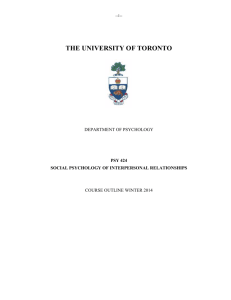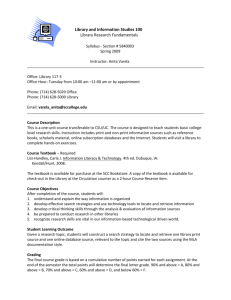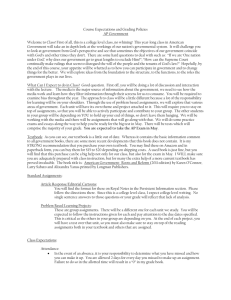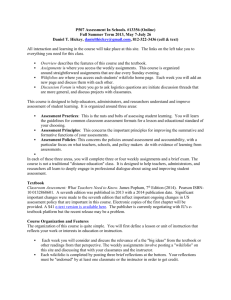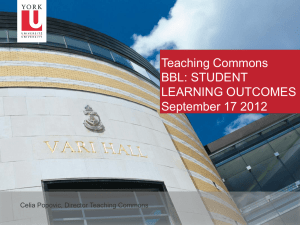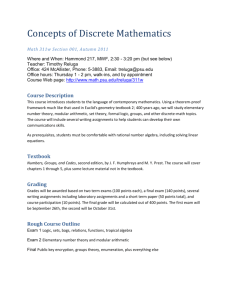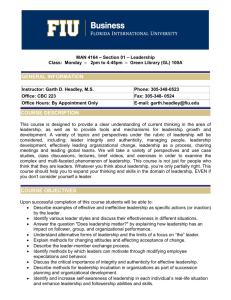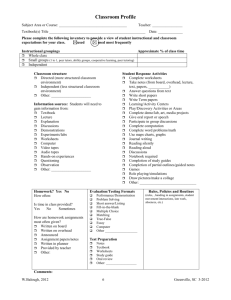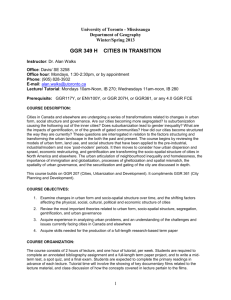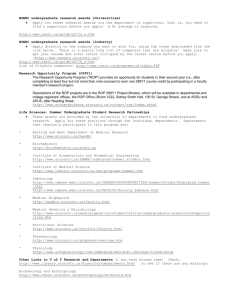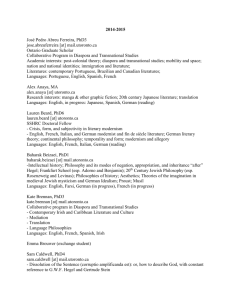PSY 424: Social Psychology of Interpersonal Relationships
advertisement
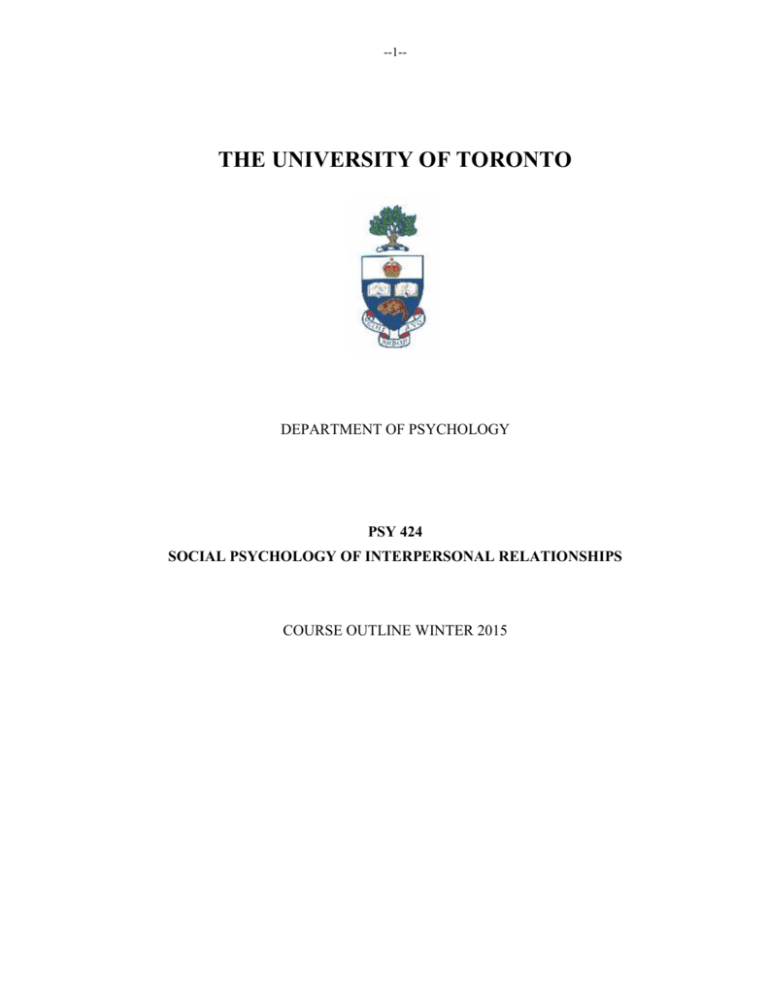
--1-- THE UNIVERSITY OF TORONTO DEPARTMENT OF PSYCHOLOGY PSY 424 SOCIAL PSYCHOLOGY OF INTERPERSONAL RELATIONSHIPS COURSE OUTLINE WINTER 2015 --2-- Instructor: Dr Geoff MacDonald Room: Sidney Smith 4010 Phone: 416-978-3840 email: gmacdonald@psych.utoronto.ca Office hour: Wednesdays 1-2 Teaching Assistant: Claire Midgley Room: Phone: email: Lecture time: Wednesday 6:00 – 9:00 pm in Sidney Smith 2108 Sidney Smith 121 416-978-3210 claire.midgley@mail.utoronto.ca Required Text: Miller, R. (2015). Intimate Relationships, 7th Edition. Toronto: McGraw Hill. Course Overview: The objective of this course is to review what relationship science can tell us about close relationships, with a particular focus on romantic relationships. We will explore questions such as: Why do we want to be in relationships, what informs our choice of relationship partners, what predicts satisfaction and stability in relationships, and what is the role of sexuality in relationships? These and other questions will be examined from a variety of theoretical perspectives and will be applied to better understand real-world relationship functioning. Prerequisite courses: PSY201H1 (or equivalent); PSY220H1. It is your responsibility to ensure that you have met all prerequisites listed in the Psychology section of the A&S Calendar for this course. If you lack any prerequisites you WILL BE REMOVED. No waivers will be granted. Assessment: There are four pieces of assessment for this course--two assignments (the first worth 20% and the second worth 30%) and two tests (each worth 25%). Note that there is no final exam. 1. Primary Source Report. The first assignment asks you to check the accuracy of one study cited in your textbook readings for the first half of the course (i.e., Chapters 1, 2, 3, 4, 6, and 8). You are to select one citation and read the paper cited. In your paper, you will summarize the textbook’s description of the research, and provide your own more detailed description of the work. Then, you will critically analyse the fit between the textbook’s description of the research, the message the authors of the paper wished to convey, and your own independent reading of the paper. The paper is due at the START OF CLASS on Wednesday February 4th. See below for specifics. (20%) 2. Applying Research Findings. The second assignment asks you to find examples and counterexamples for findings in relationship research and use these to generate new research ideas. You are to select one citation from the textbook readings for the second half of the course (i.e., Chapters 5, 9, 10, 11, 12, 13, & 14) and read the paper cited. In your paper, you will first describe the research, then provide one example of a relationship or relationship event that supports the phenomenon described by the researchers and one that does not support the phenomenon described by the researchers. The examples will be used as a basis to discuss the applicability of the research to real-world relationships. Finally, using the examples to illuminate under what conditions the phenomenon does and does not apply, you will propose how the research could be improved to better test the applicability of the findings to real-world relationships. The paper is due at the START OF CLASS Wednesday March 25th. See below for specifics. (30%) --3-- 3. Test 1. The test will consist of short answer and essay questions on February 11th. (25%) 4. Test 2. The test will consist of short answer and essay questions on April 1st. (25%) Policy on missed tests: If one of the two tests is missed, appropriate documentation such as a medical certificate or college registrar’s note (as well as a copy of the ROSI Absence Declaration) must be provided to the instructor within one week of the missed test (See Faculty of Arts and Sciences Calendar). There are no make-up tests. If satisfactory documentation is provided, the missed test will be accounted for by increasing the value of the other three pieces of assessment; the first assignment will be worth 25%, the second assignment worth 35%, and the remaining exam worth 40%. Late assignments: Assignment 1 is due at the START OF CLASS on February 4th. Assignment 2 is due at the START OF CLASS March 25th. Assignments can be submitted either in class or to the instructor’s mailbox (SS4016). Assignments delivered after the start of class on due dates will be considered 1 day late. The late penalty is 5% per working day (Monday – Friday). Course website on Blackboard: I have constructed a course website via Blackboard which can be accessed by logging in to http://portal.utoronto.ca. Lecture notes will be posted here before each class. I will also post the syllabus, announcements, and useful links on the site. There is also space on the site for students to begin discussion forums for discussing topics such as assignments and tests or aspects of the content of the course. Email policy: I will respond as quickly as possible to email inquiries, although I do not answer email on weekends. Accessibility Needs: Students with diverse learning styles and needs are welcome in this course. In particular, if you have a disability/health consideration that may require accommodations, please feel free to approach me and/or Accessibility Services at (416) 978 8060; accessibility.utoronto.ca. Writing: As a student here at the University of Toronto, you are expected to write well. The university provides its students with a number of resources to help them achieve this. For more information on campus writing centres and writing courses, please visit http://www.writing.utoronto.ca/. Academic Integrity and Plagiarism: Academic integrity is essential to the pursuit of learning and scholarship in a university, and to ensuring that a degree from the University of Toronto is a strong signal of each student’s individual academic achievement. As a result, the University treats cases of cheating and plagiarism very seriously. The University of Toronto’s Code of Behaviour on Academic Matters (www.governingcouncil.utoronto.ca/policies/behaveac.htm) outlines the behaviours that constitute academic dishonesty and the processes for addressing academic offences. All suspected cases of academic dishonesty will be investigated following procedures outlined in the Code of Behaviour on Academic Matters. If you have questions or concerns about what constitutes appropriate academic behaviour or appropriate research and citation methods, you are expected to seek out additional information on academic integrity from your instructor or from other institutional resources (see www.utoronto.ca/academicintegrity/resourcesforstudents.html). --4-- Lecture Timetable: Week Date Lecture Topic Reading 1 January 7th Ch. 1 & 2 2 January 14th 3 January 21st 4 January 28th 5 February 4th 6 February 11th Animal instinct: The deep roots of the desire for intimate connection The mating marketplace: Gender, evolution, and socialization Lose yourself or find yourself? Merging self and other Is monogamy natural? The dynamics of commitment Attachment: From the cradle to the grave (paper 1 due) Term Test 1 in Galbraith Building room 304 7 February 18th Reading Week!!!! 8 February 25th Sexuality: Naked truths Ch. 9 9 March 4th Relationships and health Ch. 10 10 March 11th none 11 March 18th 12 March 25th 13 April 1st Love, tradition, and family: Relationships across cultures Communication and conflict: The imperfect means of accommodation Survival through growth: Maintaining relationships (paper 2 due) Term Test 2 in Galbraith Building room 304 Ch. 3 Ch. 4 Ch. 6 Ch. 8 Ch. 5, 11 & 12 Ch. 13 & 14 --5-- Assignment 1: Media Report Objectives: The main objective is to examine the accuracy of research reported in media stories of relationship research published in the media during or after November 2014. The media have taken a heightened interest in relationship research in recent years. In this assignment, you will determine for yourself whether a news story that you select has accurately portrayed the original research. Due date: The paper is due at the START OF CLASS on Wednesday February 4th. General requirements: You are to select one story from a media outlet about relationship research and look up the corresponding journal article (if the story cites more than one article, select one to focus on). You should summarize the media’s description of the research, and provide your own more detailed description of the work. Then, critically analyse the fit between the media’s description of the research and your own independent reading of the paper. Finally, conclude with reflection on what this specific case might reveal more broadly about when you should and should not trust media reports about research. Specific requirements: The paper should be a maximum of 4 double-spaced pages, not including title page and references (most papers should only require 2 references, the paper you are examining and the textbook). Papers must be in 12-point Times font. Required sections: • opening thesis • media story description: discuss the media report about the study (if the story is online, include a link to the original media story) • research article: provide a description of the logic behind the research, how the study was conducted, the research results, and the authors’ interpretation of their results • synthesis: compare the interpretations of the research provided by the media and the original article • conclusion: what does this case suggest about when media reports are likely to be more or less accurate in presenting relationship research Suggestion: Better papers will incorporate a competent analysis of the research results, so you should select a paper that uses statistics you understand. --6-- Assignment 1 Marking Scheme • first paragraph: your thesis (10%) – foreshadow your conclusion (be specific) • description of study in media outlet (10%) – overview of how the media story describes the study, if the story is online provide a link • description of research paper (20%) – demonstrate you understand the research - clear and coherent description that is free of jargon – describe it verbally, do not use numbers (e.g., statistical tests, number of participants) unless it is relevant to your argument • synthesis: comparison of media report and journal article (40%) – how fully and fairly did the media report depict the study? • conclusion section (20%) – what broader conclusions can you draw about when media reports about relationship research should and should not be trusted? --7-- Assignment 2: Applying Research Findings Objectives: This assignment has two main objectives. The first objective is to develop your skills in applying research to relationships in the real world. Any published study has merits that may help you understand your own relationships, but each study also has limitations that may interfere with its applicability to a specific relationship. The second objective is to help develop your ability to use real-world experiences to inform your development of research ideas. One way to advance research and theory is to think of situations in which a particular phenomenon may operate differently. By generating counter-examples to existing research, you should be able to uncover variables that may influence a psychological phenomenon that researchers in that area have not previously considered. Due date: The paper is due at the START OF CLASS on Wednesday March 25th. General requirements: The second assignment asks you to find examples and counter-examples for findings in relationship research and use these to generate new research ideas. You are to select one citation from the textbook readings and read the paper cited. The paper must be an empirical study and not a review paper. In your paper, you should first describe the research. You should then provide one example of a relationship or relationship event that supports the phenomenon described by the researchers and one that does not. These examples can be taken from your own experiences with relationships, the experiences of others who you know, or from popular culture (e.g., books, tv, movies). The examples should be used to discuss the applicability of the research to real-world relationships. Finally, using the examples to illuminate under what conditions the phenomenon does and does not apply, propose how the research could be improved to better test the applicability of the findings to real-world relationships. Specific requirements: The paper should be a maximum of 6 double-spaced pages, not including title page and references. Papers must be in 12-point Times font. Required sections: • title page • article description: provide a description of the logic behind the research, how the study was conducted, the research results, and the authors’ interpretation of their results • supporting example: provide an example from a relationship that is consistent with the research findings, and use the example to comment on the applicability of the research • contradictory example: provide an example from a relationship that is inconsistent with the research findings, and use the example to comment on the limitations to the applicability of the research. Be specific about what aspects of this relationship or what conditions may have led the research not to apply in this case • research ideas: using the variables identified in the previous section as influencing the phenomenon of interest, suggest improvements to the research conducted in the target article that could improve its applicability • references Suggestion: Better papers will include references from the academic literature that examine the variables you identify in the contradictory example section. By examining what research has shown about these variables in past research, you should be able to better refine your research ideas. Assignment 2 Marking Scheme --8-- • • • • • first paragraph: your thesis (5%) – foreshadow your conclusion (be specific) description of research paper (10%) – so a naïve reader can understand what the researchers did (avoid jargon) – describe it verbally, do not use numbers (e.g., statistical tests, number of participants) supporting example (20%) – specific personal examples, examples of those known to you, popular media examples (just make clear where you got this example) – do not use hypothetical or generalized examples contradictory example (25%) – identify 1-3 specific variables that can account for the counter-example – do not simply speculate what those variables may be, but provide an evidence-based argument as to why those variables can account for the anomaly you’ve identified research ideas (40%) – describe what is known about those variables in existing literature – describe how the researchers could alter their study to test those variables – say specifically what results you would predict (i.e., don’t just say it would be interesting to examine X….say what effect you think X would have) --9-- Assignment Submission Instructions 1. Complete the assignment outside of Blackboard (e.g., Microsoft Word) and save to your computer or a portable storage devise (CD, USB key). 2. Please name your file as follows: Assignment#- student number (e.g. Assignment #19999999). Please do not include your full name in the filename. 3. From within our Blackboard page, go to the Course Materials page. 4. Click on the relevant assignment. 5. Attach your assignment by clicking on “Browse my computer” and selecting your document. Double check that the correct document is listed next to “Attached Files.” In the comments section, provide a clear title for what is being submitted (e.g., Assignment 1 – student number). No additional comments are necessary. 6. Click “Submit.” Selecting “Save as Draft” does not submit the assignment, and such saved assignments will not be considered for evaluation after the due date. You should receive a response that indicates that your paper has been submitted to the instructor.
